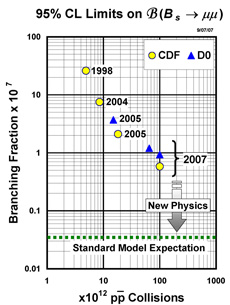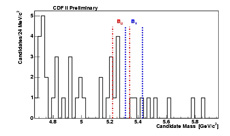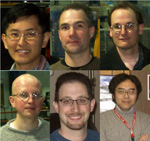|
Thursday, Sept. 13
1 p.m.
ILC ALCPG Physics and Detector R&D Seminar - West Wing, WH-10NW
Speaker: A. Mezzacane, INFN, Lecce
Title: Jet Reconstruction and Resolutions for Dual Readout Calorimetry
2:30 p.m.
Theoretical Physics Seminar - Curia II
Speaker: G. Villadoro, Harvard University
Title: A Measure of de Sitter Entropy and Eternal Inflation
3:30 p.m.
DIRECTOR'S COFFEE BREAK - 2nd Flr X-Over
4 p.m.
Accelerator Physics and Technology Seminar - One West
Speaker: M. Chung, Princeton Plasma Physics Laboratory
Title: Studies of Charged Particle Beam Dynamics on the Paul Trap Simulator Experiment (PTSX)
Fri., Sept. 14
3:30 p.m.
DIRECTOR'S COFFEE BREAK - 2nd Flr X-Over
4 p.m.
Joint Experimental-Theoretical Physics Seminar - One West
Speaker: A. Khanov, Oklahoma State University
Title: Standard Model Higgs Searches at DZero
8 p.m.
Fermilab International Film Society - Auditorium
Tickets: Adults $5
Title: Rang De Basanti (Paint it Yellow)
Saturday, Sept. 15
8 p.m.
Fermilab Arts Series: Buckwheat Zydeco- Auditorium
Tickets: $25/$13
Click here for NALCAL,
a weekly calendar with links to additional information. |
Thursday, Sept. 6
- Southwestern chicken tortilla
- Philly style cheese steak
- *Garlic herb roasted pork
- Tomato basil chicken parmesan
- Southwestern turkey wrap
- Assorted slice pizza
- *Marinated grilled chicken caesar salads
*Carb restricted alternative
Wilson Hall Cafe menu |
|
Thursday, Sept. 6
Dinner
- Tomato & mozzarella salad
- Stuffed fillet of sole w/crabmeat
- Vegetable medley
- Chocolate soufflé w/amaretto crème anglais
Wednesday, Sept. 12
Lunch
- Stuffed summer vegetables
- Fresh ginger cake
Chez Leon menu
Call x4598 to make your reservation. |
|
|
DOE's Office of Science launches U.S. LHC Web site

U.S. LHC Web site - one stop shopping for information on the U.S. role in the LHC
WASHINGTON, DC - The U.S. Department of Energy's Office of Science today launched a new Web site to tell the story of the U.S. role in the Large Hadron Collider, a particle accelerator that will begin operating in Europe, near Geneva, Switzerland, next year. Hundreds of physicists, engineers and students from the United States are joining with colleagues from around the globe in the largest and most complex scientific experiments ever built. The LHC experiments will address some of the most fundamental mysteries of the universe.
The new website, www.uslhc.us, funded by DOE's Office of Science, aims to provide one-stop shopping for anyone seeking information about the United States and the LHC. Updated daily, the Web site features up-to-the-minute news and information about the LHC, along with high-resolution graphic images, scientists' blogs, resources for students and educators and contact information for news media.
"The LHC will become the world's highest-energy particle accelerator when it is scheduled to turn on in 2008," said Dr. Robin Staffin, DOE's associate director of Science for High Energy Physics said. "The United States has played key roles in the design and construction of both the LHC experiments and the accelerator. The new Web site will tell the story of U.S participation in this extraordinary scientific adventure as it unfolds."
The LHC is located at CERN, the European Organization for Nuclear Research, near Geneva, Switzerland. The LHC, 27 kilometers in circumference, has been more than 15 years in the making. The machine accelerates protons to almost the speed of light and makes them collide in the center of four cathedral-sized experiments, creating conditions that existed billionths of a second after the Big Bang. Scientists will use the information from these collisions to investigate the nature of the physical universe.
Read the DOE press release here.
|
Seven-digit dialing a thing of the past in 630 area
Perhaps you already have read or heard about the approaching implementation of a new area code 331 and the associated change to dialing procedures. For those who haven't heard, the increased demand for telephone numbers as well as increased competition in the telecommunications industry has prompted the change. Illinois Commerce Commission developed and approved a new area code "overlay" as a relief plan to provide additional prefixes to the present 630 geographic area. As a result, 11-digit or 1+ dialing will become mandatory on Oct. 7, 2007, for all calls placed within the 630 area.
It is recommended that you take an inventory of all devices in your work areas as well as in your home that may be preprogrammed to dial a 7-digit number string and change that number to 11 digits. Remember to precede the phone number with a 9+1 on laboratory devices. Since permissive 1+ dialing already is in effect, you may begin reprogramming devices immediately or at least prior to Oct. 7.
Examples of devices to review include: landline phones, cellular phones, fax machines, modems or other automated dialing equipment. Also, remember to check your internet dial-up numbers, speed dial lists and call forwarding settings.
There will be no impact to calling rates for local calls regardless of the number of digits dialed and, of course, our internal 4-digit lab dialing will not be affected. More information is available here or through the Telecommunications Office at x5411 or telecom@fnal.gov.
|
Grids point to pollution solutions

eMinerals' scientists are using grid computing to delve into the chemical substitutions that lead to arsenic contamination of drinking water. This image shows an arsenic atom (purple) substituted for a sulfur atom (cream) rather than an iron atom (red) in the structure of pyrite.
Image courtesy of Kat Austen and Marc Blanchard
eMinerals scientists will deliver new dirt on soil pollution at the 7th UK e-Science All Hands Meeting in Nottingham this week.
The eMinerals team, funded by the UK's Natural Environment Research Council, is using grid computing to tackle some serious environmental problems, including arsenic contamination of drinking water and dioxin pollution of soils.
Read More
|
Small 'hobbit' galaxies made almost entirely of dark matter
From Space.com, Sept. 12, 2007
Small, ultrafaint "hobbit" galaxies recently found hovering around our Milky Way are comprised almost entirely of dark matter, a new study confirms.
Dark matter is a mysterious substance scientists think accounts for most of the mass in the universe but that is invisible to current instruments.
Read more
|
Stanford's X-ray vision
From CNET news.com, Sept. 11, 2007
The Stanford Linear Accelerator Center is home to breakthroughs in particle physics and astrophysics, including the discovery of quarks, one of the two smallest known components of matter.
Six Nobel prizes have been won related to work done here, most recently by chemist Roger Kornberg for discovering how genetic instructions are carried out within cells.
Journalists attending the Society of Environmental Journalists conference in Palo Alto, Calif., took a closer look at the Stanford University facilities on Saturday.
Read more
|
|
|
Searching for 23 percent of the universe at the Tevatron

This plot shows the history of the limit on the branching ratio of Bs for the Tevatron experiments.
One of the most intriguing questions for physics is what makes up the universe, and amazingly, the subatomic particles at CDF can help answer this question. Using the most current measurements of visible matter, we can account for only 4 percent of the universe. The remainder of the universe is split into: 23 percent dark matter, observed through its gravitational interactions, and 73 percent dark energy, observed through the expansion of the universe.
A key connection between particle physics and cosmology is the assumption that the dark matter, which was created a few billions of a second after the Big Bang, is composed of elementary particles. Since none of the known Standard Model particles can be the dark matter, we need a new theory that provides a dark matter particle.
Supersymmetry is one of the most appealing new theories of particle physics, and predicts that every particle has a superpartner. This theory provides a dark matter candidate - the lightest neutral superparticle. Being the lightest particle it cannot decay, and would remain scattered in the universe.
So, how can we explore supersymmetry? The Standard Model predicts that the rate of a bottom-strange quark meson (Bs) decaying into two muon-type leptons is extremely small. It is comparable to you being picked randomly from the entire population of the U.S. It requires quadrillions of proton-antiproton collisions for the decay to be seen at the Tevatron. If supersymmetry is correct, we should expect an enhancement in the Bs decay rate by 2-3 orders of magnitude. If observed, it would be an indication of new physics.
A team of physicists at CDF examined 100 trillion proton-antiproton collisions and searched for di-muon events. The team made improvements in several key areas including identification of the muon, and ability to separate signal from background. No events over the expected level of background were seen, setting limits of its decay rate at 5.8 x 10-8 for Bs, an order of magnitude larger than the Standard Model prediction. Simultaneously, the team set a limit on the decay rate of 1.8 x 10-8 for Bd, a related particle. These are the world's best limits, and can constrain the predictions from supersymmetry and other theories, thus narrowing the region of searches for new physics. In the future, we will be better able to probe cosmology as the Tevatron produces even more proton-antiproton collisions.
Learn more

This plot shows the di-muon mass distribution for events after the final selection cuts.
 |
| The following scientists worked on this analysis. (Clockwise from top left): Cheng-Ju Lin, Lawrence Berkeley National Laboratory; Doug Glenzinski, Fermilab; Matt Herndon, University of Wisconsin; Teruki Kamon and Michael Weinberger, Texas A&M University; and Slava Krutelyov, UC-Santa Barbara. (Click on image for larger version.) |
Result of the Week Archive
|
|
Have a safe day!
A-0 parking lot closures Sept. 14
On Friday, Sept. 14, the north end of A-O parking lot will be closed for crack filling, seal coating, and re-striping. That section will reopen on Monday, Sept. 17. The south half of the A-O lot will be closed Sept. 17 for similar work. Please use the far west Wilson Hall lot and the gravel over-flow lot across from Booster West for alternate parking. All work will be weather dependent.
TIAA- CREF financial education seminar
Today, TIAA-CREF will hold a financial education seminar titled "Your Retirement Income Options." Individual consultant Chad Stein will present the seminar, which focuses on several types of available income options. The presentation will be given at 10 a.m. and 1 p.m. in the Curia II conference room located on the 2nd floor of Wilson Hall, southwest side of the building.
Buffalo Fest on Friday
From 4 to 6 p.m. Friday, Sept. 14, the Users' Center will host Buffalo Fest on its patio. Buffalo burgers and sausage are $5 each; hot dogs are 2 for $5. All sandwiches come with chips. No Fermilab buffalo were harmed for this festival.
International Folk Dancing today
International Folk Dancing will meet today, Sept. 13, at Kuhn Barn on the Fermilab site. Dancing begins at 7:30 p.m. with teaching and children's dances earlier in the evening and request dancing later on. Newcomers are welcome. You do not need to come with a partner. Information at (630) 584-0825 or (630) 840-8194 or folkdance@fnal.gov.
Register for ALCPG07
The joint meeting of the American Linear Collider Physics Group and ILC
Global Design Effort will take place at Fermilab Oct. 22-26. The
deadline to register is Oct. 12. A block of rooms has been reserved for
meeting attendees at the Pheasant Run Resort in St. Charles. This block
of rooms will only be held until Sept. 19. Meeting attendees are
encouraged to book your rooms soon. Questions? Contact Cynthia M. Sazama.
More information
Wanted: Graduate students for ALCPG07
Are you a graduate student who would like free food and a T-shirt? Volunteer
to be a scientific secretary at the ALCPG/GDE meeting at Fermilab on
Oct. 22-26. For details contact Andreas Kronfeld.
Additional Activities |
|